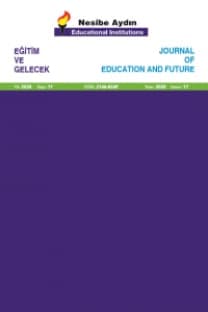Öğretmen Adaylarının Öğretmenlik Mesleğine Yönelik Tutumlarındaki Farklılıklar
öğretmen eğitimi, öğretmenlik tutumları, meslek seçimi, program etkililiği
Attitudinal Differences of Teacher Candidates towards the Teaching Profession
___
- Allport, G.W. (1935). Attitudes. In C. Murchison (Ed.), Handbook of social psychology. Worcester, Mass: Clark University Press.
- Boger, C. & Boger, D. (2000). Preservice teachers’ explanation of their teaching behavior. Journal of Instructional Psychology, 27 (4), 217-223.
- Creswell, J.W. (2003). Research Design: Qualitative, Quantitative and Mixed Methods Approaches. Sage Publications.
- Deci, E. L. (1971). Effects of externally mediated rewards on intrinsic motivation. Journal of Personality and Social Psychology, 18, 105–115.
- HEC. (2007). Öğretmen Yetiştirme ve Eğitim Fakülteleri (1982-2007). Yükseköğretim Kurulu Yayını: Ankara.
- Jöreskog, K. G. & Sörbom, D. (2001). Lisrel 8: User's reference guide. Chicago, IL: Scientific Software International, Inc.
- Kasser, T. & Ryan, R. M. (1996). Further examining the American dream: Differential correlates of intrinsic and extrinsic goals. Personality and Social Psychology Bulletin, 22, 80–87.
- Kılınç, A., Watt, H., Richardson, P. (2012). Factors influencing teaching choice in Turkey. Asia Pacific Journal of Teacher Education, 40 (3), 199-226.
- Miles, M.B. & Huberman, A.M. (1994) Qualitative data analysis: an expanded sourcebook (2th Ed). California: Sage Publications.
- Moran, A., Kilpatrick, R., Abbot, L., Dallat, J. & Mc Clune, B. (2001). Training to teach: motivating factors and implications for recruitment. Evaluation and Research in Education, 15 (1), 17-32.
- Oral, B. (2004). The attitudes of students of education faculty toward teaching profession. Eurasian Journal of Educational Research, 15, 88-98.
- Richardson, P.W. & Watt, H.M.G. (2006). Who chooses teaching and why? Profiling characteristics and motivations across three Australian universities. Asia-Pacific Journal of Teacher Education, 34, 27–56.
- Ryan, R. M. & Deci, E. L. (2013). Toward a social psychology of assimilation: Self-determination theory in cognitive development and education. In B. W. Sokol, F. M. E. Grouzet, U. Muller (Eds.), Self-regulation and autonomy: Social and developmental dimensions of human conduct (191-207). Cambridge, England: Cambridge University Press.
- Ryan, R. M., Huta, V. & Deci, E. L. (2008). Living well: A self-determination theory perspective on eudaimonia. Journal of Happiness Studies, 9, 139-170.
- Saracaloğlu, S., Serin, O., Bozkurt, N. & Serin, U. (2004). The factors that affects the attitudes of the candidate teachers towards teaching profession. Çağdaş Eğitim, 311, 16-27.
- Schermelleh-Engel, K. & Moosbrugger, H. (2003). Evaluating the fit of structural equation models: tests of significance and descriptive goodness-of-fit measures. Methods of Psychological Research Online, 8(2), 23–74.
- Sullivan, S.O. (2014). Becoming a teacher in the United States: are attitudes of incoming candidates malleable? Athens Journal of Education, 1 (1), 45-56.
- Tok, Ş. (2011). Pre-service primary education teachers’ changing attitudes towards teaching: a longitudinal study. European Journal of Teacher Education, 34 (1), 81-97.
- Uğurlu, C. T. & Polat, S. (2011). Sınıf öğretmenliği öğrencilerinin öğretmenlik mesleğine ilişkin tutumları. Cumhuriyet Üniversitesi Sosyal Bilimler Dergisi, 35 (1), 68-74.
- Üstüner, M. (2006). Öğretmenlik mesleğine yönelik tutum ölçeğinin geçerlik ve güvenirlik çalışması. Educational Administration: Theory and Practice, 45,109-127.
- Üstüner, M., Demirtaş, H. & Cömert, M. (2009). The attitudes of prospective teachers towards the profession of teaching (The case of İnönü University, Faculty of Education). Education and Science, 34 (151), 140-155.
- Wang, H. & Fwu B.J. (2001). Why teach? The motivation and commitment of graduate students of a teacher education program in a research university. Practical National Science Council, Roc (C), 11 (4), 390-400.
- Watt, H.M.G, Richardson, P.W. (2012). An introduction to teaching motivations in different countries: comparisons using the FIT-Choice scale. Asia-Pacific Journal of Teacher Education, 40 (3), 185–197.
- ISSN: 2146-8249
- Yayın Aralığı: Yılda 2 Sayı
- Başlangıç: 2012
- Yayıncı: Nesibe Aydın Eğitim Kurumları
Ramazan Sak** Feyza Tantekin Erden*** İkbal Tuba Şahin Sak**** Hadi Esmeray
Ramazan SAK, Feyza TANTEKİN ERDEN, İkbal Tuba ŞAHİN SAK, Hadi ESMERAY
Guided Inquiry-Based Electricity Experiments: Pre-service Elementary Science Teachers’ Difficulties
A. Selcen Arslangilay** M. Çağatay Özdemir
A. Selcen ARSLANGİLAY, M. Çağatay ÖZDEMİR
Öğretmen Adaylarının Öğretmenlik Mesleğine Yönelik Tutumlarındaki Farklılıklar
Pre-Service Social Studies Teachers’ Perception of Global Citizenship
Sibel Karaca* Özgür Yeşiloğlu ** Önder Şimşek
Sibel KARACA, Özgür YEŞİLOĞLU, Önder ŞİMŞEK
Fatih Mehmet Ciğerci* Fisun Güngör
Fatih Mehmet CİĞERCİ, Fisun GÜNGÖR
Pattern Analysis of the First Part of Beethoven Waldstein Piano Sonata in Terms of Motives
Sınıf Öğretmenlerinin Okul Dışı Öğrenme Ortamlarından Yararlanmaya İlişkin Görüşleri
